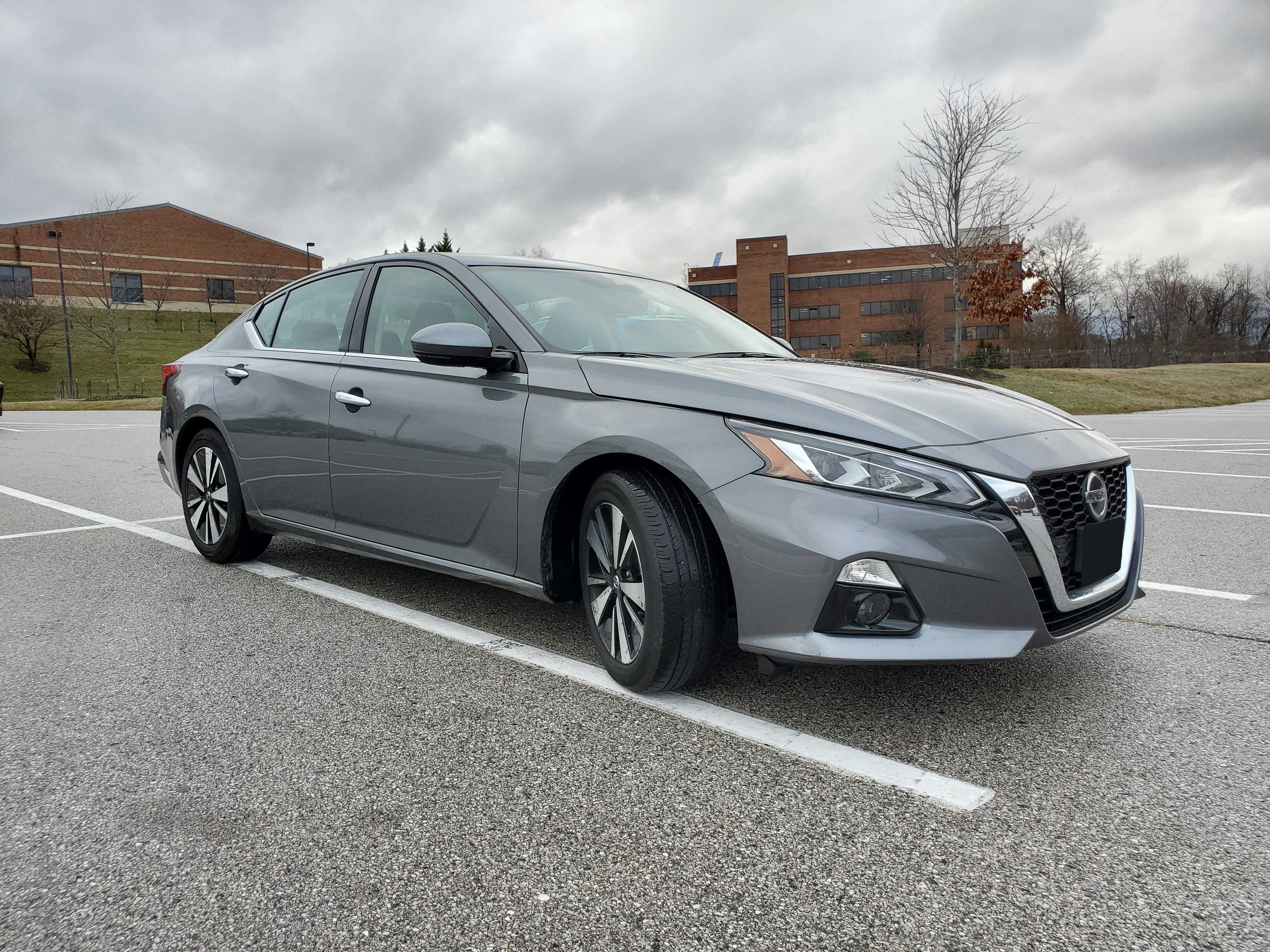
The Nissan Altima takes the "grand" out of "grand tourer." It's a super-commuter's chariot, a grocery store franchise owner's limousine, the vehicle of choice for the dad who is both too considerate to get an SUV and too sensible to get a full size sports sedan. The Nissan Altima is a car that does not attept to be all things for all people, like the Civic or Corolla. Instead, it sits smugly in its market niche, comfortable among peers like the Chevrolet Malibu, Honda Accord, and Toyota Camry. The Altima talks the talk a modern midsize car is almost required to, pretending on the outside to be a sports sedan, but inside, it walks the walk of a daily driver, with soft yet predictable steering, good fuel economy, and tall highway gearing. The Altima may not be particularly exciting, but therein lies its strength. As I mentioned in my review of the Nissan Kicks, sometimes predictable sells more than quirky does.
What is it like?
My first instinct was to compare the Altima to the other midsize sedan I had driven recently, the Volkswagen Passat. I expected similar power, handling, and UX design, but I ultimately found that Nissan followed their own design philosophies pretty faithfully, those being easy driving, a wide variety of quality-of-life features, and spacious cabins.
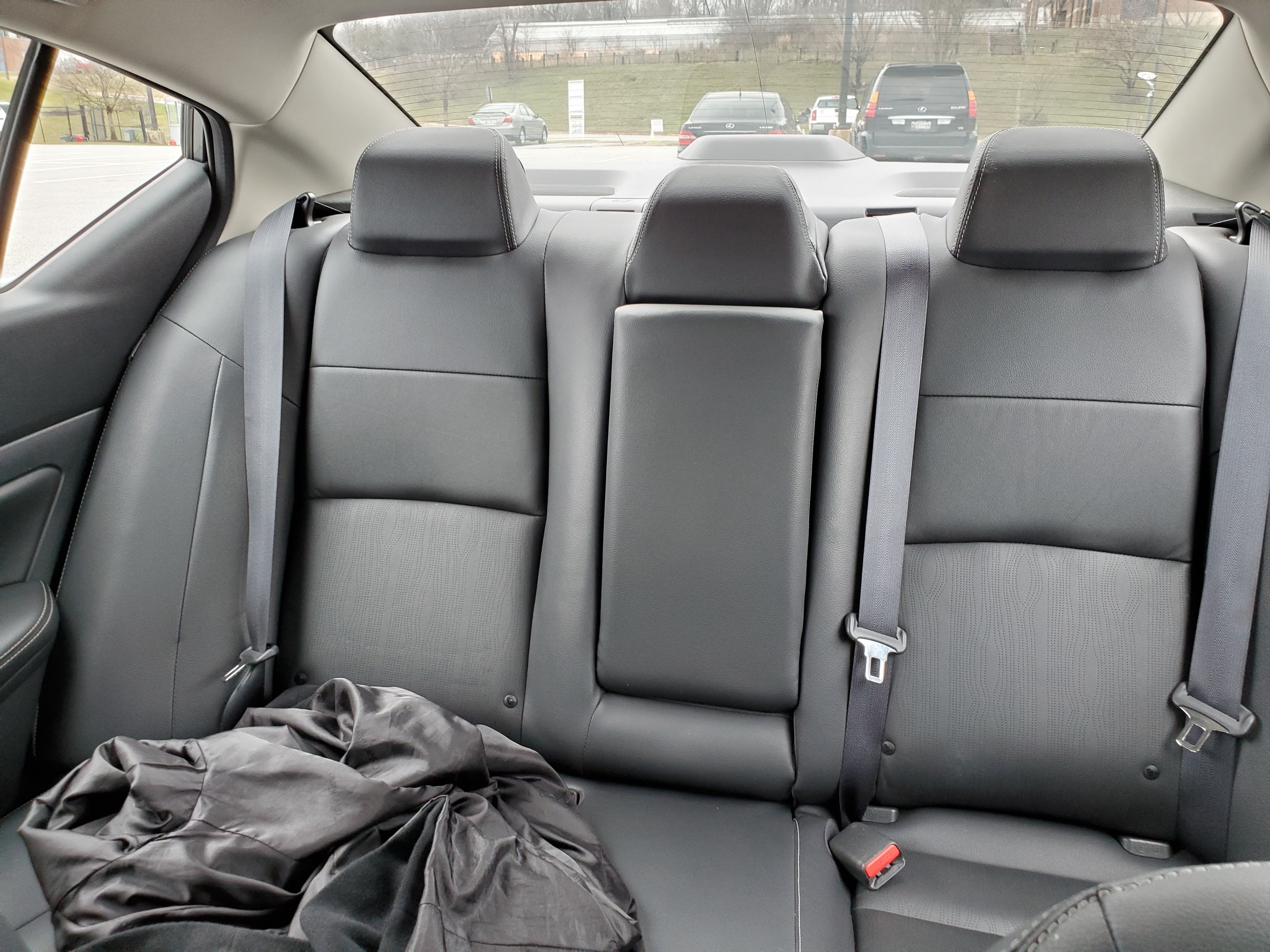
Nissan's user-end design philosophy is one that leans heavily on features and appearances, sacrificing nuance in favor of overall perceived value. As has been discussed before on this blog, this is a well-founded approach: After all, human experiences are informed by our irrational perceptions, so anything that looks good and acts good enough, on some level becomes good enough.
One's perceptions of the Nissan Altima of course start with the exterior. The Altima follows Nissan's general design language, with a tall grille, a big, muscular hood, and an edgy rear end with twin tailpipes, a diffuser-inspired bumper, and one of Nissan's best pieces of design work, the slim and angular, yet sleek taillights. The Altima works hard to be perceived as a confident, muscular sports sedan on par with the Lexus IS or BMW 3-Series. It goes without saying that this is all bark and no bite, but again, the appearance of the thing matters more than the substance. This edgy styling works in the Altima's favor, as it disguises the absolutely massive passenger cabin. The sharply sloped C-pillar and prominent rear fenders hide the deep rear seating area, and the long hood offsets the visual weight of the large front doors. I found that the 2019 Versa also had a surprisingly large cabin; this was accomplished with a bulged rear roofline that gave the car an odd, top-heavy visual balance. It seems as though Nissan sought to avoid this impression with their midsize offering, and sculpted it in such a way as to find the best of both worlds: Sleek and energetic, while spacious and easy to enter and exit.
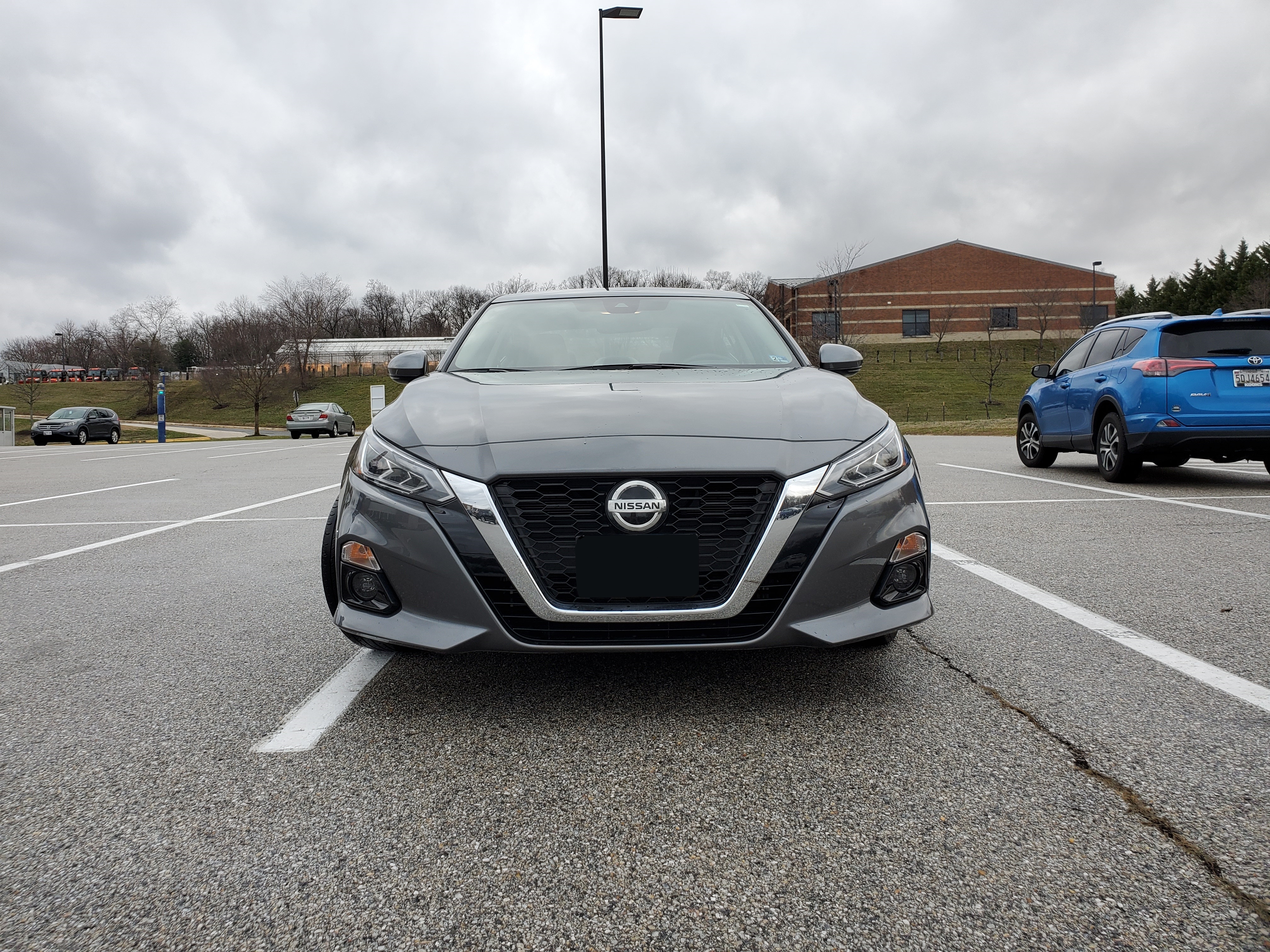
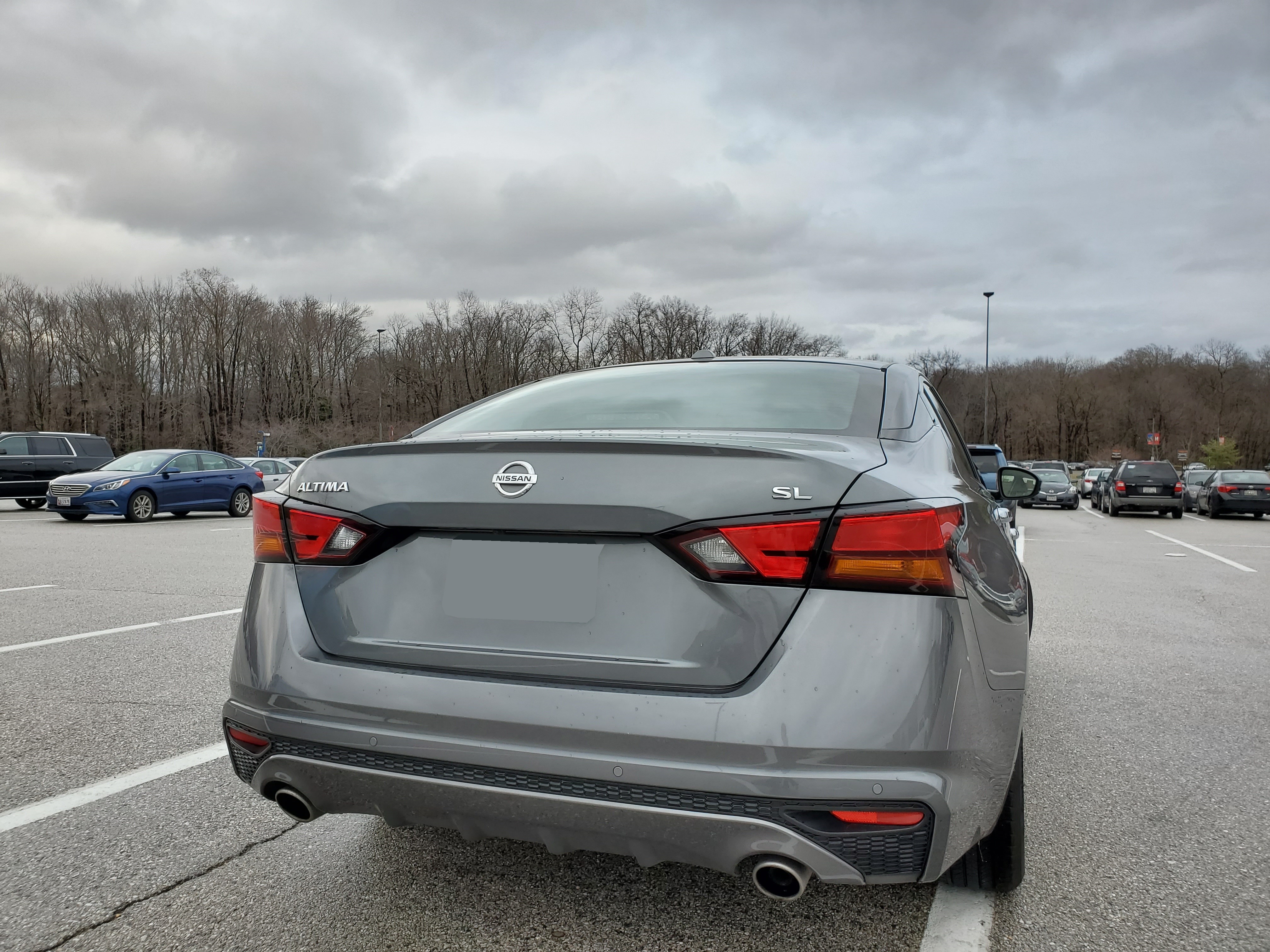

The aforementioned huge cabin of course offers generous legroom, both for front and rear seats. This car will comfortably fit four full-grown men (and one of their smaller friends for the middle seat, which, while wide, is not exactly expansive.) The center console makes up for much of the cabin width up front, with a massive armrest and big cupholders to boot. The various obligatory bins, shelves, and cubbyholes are of course present, as are USB and USB type C receptacles, for both front and rear seats. Visibility is decent, but the A-pillars are inconveniently placed, and feel visually intrusive.
From a single drive, it certainly seems as though the Altima has enough space, comfort, and charging points to carry a four person family wherever they may want to go, and the folding rear seat of course enables the carriage of your daughter's fencing foils.
For the moms up front, the dashboard and cockpit are fairly typical for a modern midsize sedan. The HVAC controls are within easy reach, and in addition to the usual assortment of functionalities, include a heated steering wheel and dual-zone climate control. The infotainment system is accessed with a freestanding screen, and this is perhaps the weakest part of the car's UI. To be fair, however, infotainment systems are also quite difficult to get right, as their continually evolving nature would imply. The screen is bright and sharp enough, but it is just far enough forwards to be difficult to reach, and the touchscreen could stand to be more responsive. There are only a few hardware buttons, which is fine for a touchscreen, but the worst (and only major) problem, in my opinion, is the absence of a "screen off" button. Most manufacturers include some way to have a one-touch button for deactivating the screen, but the only way to do so with the Altima seems to be through multiple menus, which are of course difficult to navigate with one's arm stretched out in a moving vehicle. The general styling of the dashboard area is par for the course, with the infotainment, HVAC, and instrument clusters podded off into neatly demarcated spatial zones, all tied together with a strip of imitation wood that either ruins the entire thing or adds a touch of class, depending on your viewpoint. The generally acceptable interior curiously falls apart on the doors, however: Mirror and window switches feel fragile and cheap, like the volume keys built into an airline seat, and they seem anachronistic compared to the otherwise sleek design.



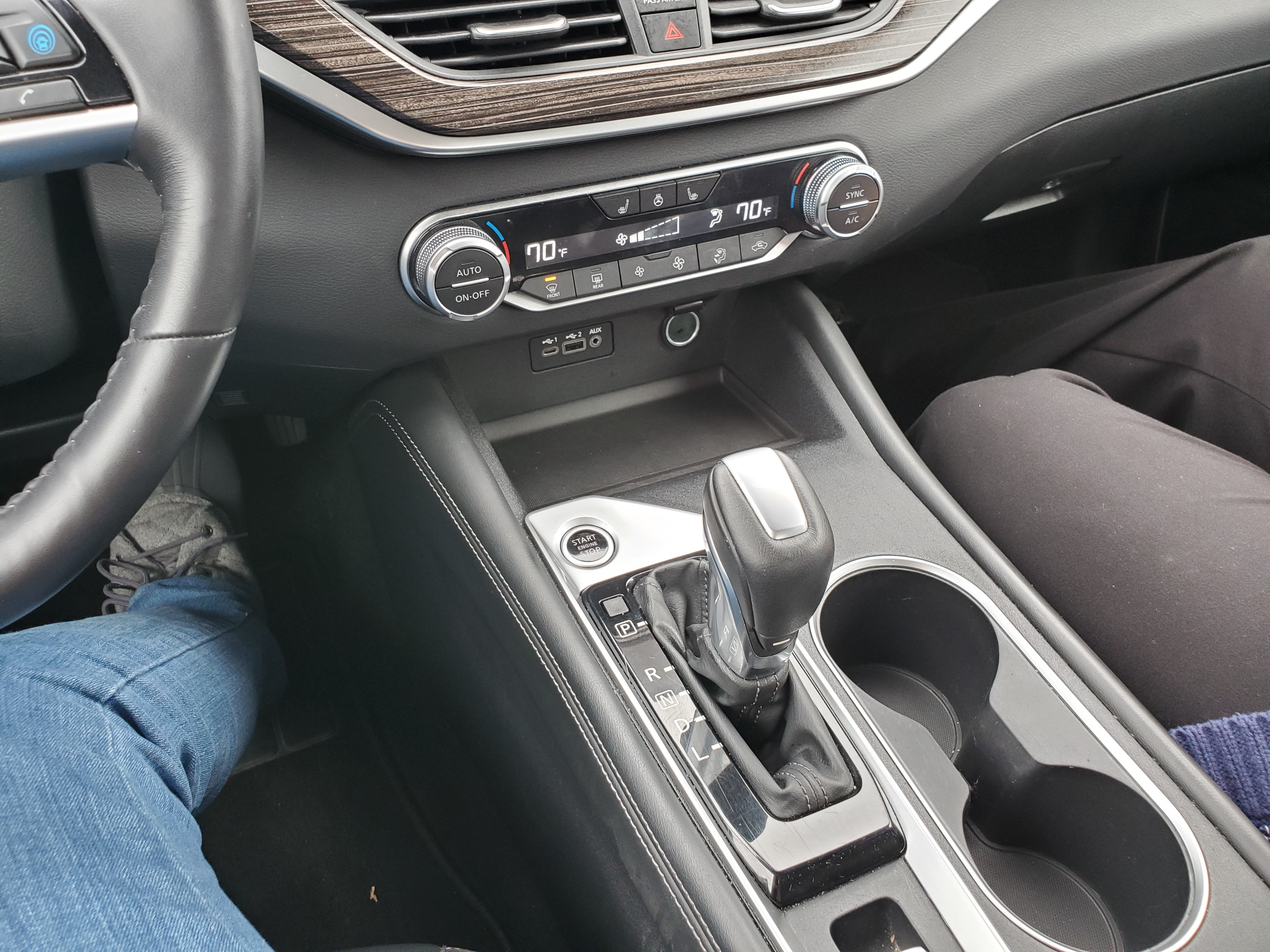
The cockpit itself, much like the rest of the interior, is par for the course for a modern, fully featured car. There are multuple information options available for the driver on the multifunction display. The steering wheel is of course cluttered with various buttons for media control, driver information, cruise control and driver assistance options, and on the SR trim, shift paddles as well, and the layout took some getting used to for me.
What is it like to drive?
I found that there was a suite of driver assistance features available, includng blind spot warning (which is rapidly becoming standard in all cars, it seems), backup beepers and automatic reverse braking, adaptive cruise control, and many others besides. On my short test drive, I did not use any of these features, but their comprehensive presence is appreciated, especially in a mass-market sedan. It seems as though driver peace of mind is a major design factor here.
Peace of mind is one thing, but the Altima pursues peace of body as well. As mentioned previously, both seat and steering wheel heaters are available, and the front seats feature electric adjustment (though the passenger's seat does not move up and down.) The seats themselves are very well-cushioned, and the side bolsters are appreciable, if not snug. The steering wheel fortunately is thin and easy to grip, instead of being huge and chunky, like some manufacturers'.
The power steering, which seems to be electric, makes for very light driver effort, especially at low speeds, which encourages palm steering. Fortunately, the wheel surface is grippy and compliant, making palm steering viable. The steering assist is of course speed-sensitive, and steering effort increases appropriately for road or highway speeds. The suspension is quite good for a car of this type, and soaks up most bumps and potholes while still communicating some, but not a lot of road feel, and the Altima feels at home on the highway. At speed, one's right hand instinctively drifts onto the inviting acreage of the center armrest, with one's palm resting on the perfectly-placed shift lever. Somehow, the cockpit feels ergonomically designed for one-hand driving (as my partner who was renting this car quite astutely pointed out), and this ergonomic design makes the Altima feel laid back, comfortable, and confident for an economy car. However, it doesn't lose its composure with both hands on the wheel, as it handles corners fairly well. Steering at speed is responsive and predictable, making both corners and "moose tests" easier on the driver, and the Altima grips the road confidently when cornering. Understeer is of course present, but is controlled, though its onset is hard to predict because of the somewhat loose and uncommunicative steering feel. While the SL trim Altima (not equipped with paddle shifters) isn't exactly a "true driver's machine," it carries its weight well, and corners like a smaller car than it is. Braking for those corners isn't exactly breathtaking, but the brakes seem strong enough to be unobjectionable, though the brake pedal is extremely sensitive, somewhat chipping away at the Altima's laid back persona.
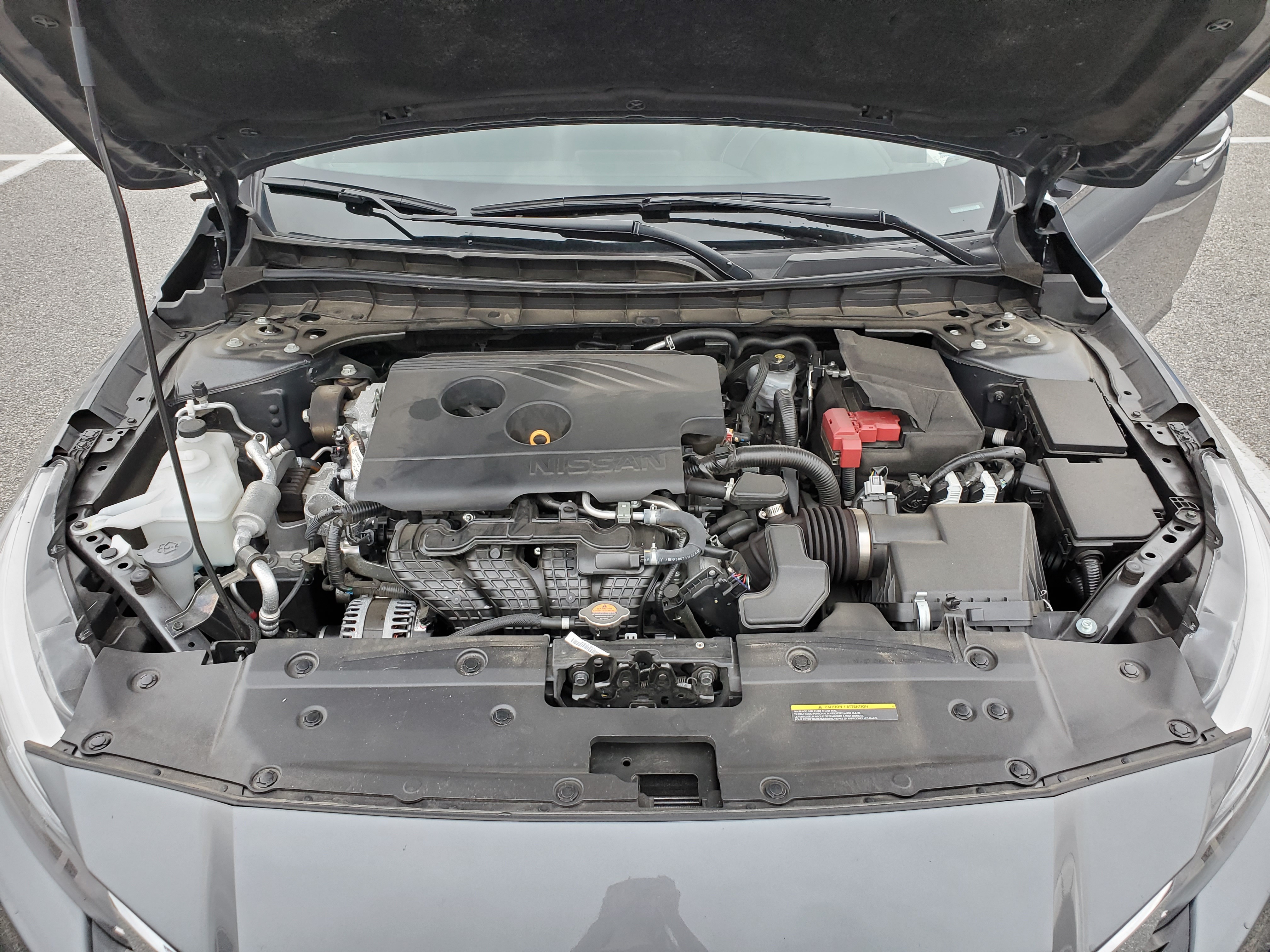

This trim of the Altima, the SL, uses a 2.5L engine that develops 188 horsepower and 180 lb-ft, according to a Nissan sales brochure. This four cylinder pushes out adequate torque at lower speeds, and when the transmission lets it really rev, it does make its nearly 190 horsepower known. However, the transmission is a CVT type, and is generally reluctant at best to let the engine really rev: One would need the SR trim, with its paddle shifters and manual mode, to really let the engine do its best work. The absence of a manumatic mode in a modern car bothers me, as the benefits it has for engine braking control, passing, and acceleration are self-evident, but the Altima does at least have a "sport mode" for the transmission, which gives the engine a bit more leeway, and the driver a slightly better soundtrack. In both normal Drive and "DriveS", which I assume to stand for "Sport" mode, the transmission programming is generally competent and responsive. The top gear and final drive ratio are nice and steep, with the engine sitting at around 1600 rpm at 60 mph, and the transmission does a good job of keeping the engine quiet for normal driving. For harder acceleration, the transmission emulates automatic shift points, avoiding the "droning" effect that seemed to be a major complaint of earlier CVTs. Engine braking of course is hard to find, since the transmission is always shooting for efficiency, but fortunately the aforementioned Sport mode is provided. Instead of being a separate shift gate from Drive, it is toggled on and off with a small button on the aft side of the shift lever. While this is easy to reach, with the driver's hand having already automatically taken its resting position on top of the shift lever, the button takes more time and mental energy to activate than simply pushing the stick back another detent. This is the basis of my complaint with GM's rocker switch actuated manumatic modes: moving a rocker switch takes more time and thought than simply knocking the stick to the side and pushing it forward or back. While the Sport mode does a great job of providing engine braking and more power, the activation of it through a small and hard to see button seems user-hostile. All transmission functions should be accessible either through moving the stick or pressing a stationary button outside of the shifter. The CVT does make intense driving less viable, but for in-town commuting and daily driving, it functions perfectly reasonably, and gets good, if not exceptional, fuel economy. The only break from expected behavior is what seems to be very obvious torque converter lockup when setting off from a stop. Automatics can get away with simply not locking the torque converter in first, but with this CVT, the lockup is quite noticeable and makes the acceleration curve feel nonlinear and unpredictable. I feel that Toyota's hybrid CVT-automatic transmission, with the direct drive first gear, likely addresses this problem somewhat.
So, the Nissan Altima is an extraordinarily spacious and appropriately comfortable midsize car, with a commute-friendly drivetrain and a suspension one could nearly call grand tourer-like. What does this all mean? Well, consider the ergonomics of the driver's station: A leisurely seating position, inviting center armrest, and a steering wheel that's easy to grip and move with one hand. This is another car, like the Toyota Prius Prime, that pushes the driver towards certain use cases and operational envelopes through the UI/UX design. While the Prius Prime grades the driver's skill, slowly training them to become a hypermiler, the Altima offers a comfortable cockpit and the feel of command of the road, training the driver to treat the road calmly and confidently. No wonder so many Altima drivers hog the passing lane: In a car like this, how could you not?
Of course, this message of "command of the road" is backed up by other aspects of the user experience. The Altima touts its driver assistance features, with prominent buttons for the activation and deactivation of various different assistance functionalities distributed around the cockpit. Nissan has realized that their sedans must do two things, in order to remain competitive for prospective crossover buyers. Not only must every sedan act as a budget sports car (since everyone knows that SUVs can't be sporty, right?), but they must also be quiet, comfortable, and actively reassuring enough to feel like a truly safe place. SUVs and pickup trucks are becoming more popular for many reasons, not least because they are more profitable for manufacturers and are subject to less stringent fuel economy standards, but they also promise the driver that they inhabit not just a car, but a fortress. A man's car is no longer just a thing to move down the road in, or a machine to attract women or friends: it is his castle, his throne, his coat of arms. We are seeing the textual reframing of car safety design features as defenses against a chaotic, hostile world. Consider the Tesla Cybertruck: it is touted as bulletproof, rock-proof, with rigid stainless steel bodywork and (ostensibly) projectile-resistant glass. It is not enough for our cars to protect us now, they must also defend us. And so, the Altima is not only a budget grand tourer, it is also a refuge from the world, a bolster against the chaotic, swelling mass of lowered Miatas and dented Cruzes.
So what does the Altima really signify? The large cabin, aggressive styling, plethora of driver assistance and safety features, and general driving experience all point to the fact that it must compete against crossovers. Midsize sedans are approximately as expensive and heavy as most compact and midsize crossovers, and adding UI and UX features into the mix that bolster driver confidence may well make all the difference. Perhaps the Altima is proof that the message SUVs send to their drivers sells as well as SUVs do in general, that transplanting that message of control, of safety, of casual intimidation into a sedan makes that sedan more desirable, more competitive. The Altima also is a very good example of Nissan's current design philosophy: Sacrifice some interior quality and driving enjoyment in order to make a car that maximizes space, comfort, and features for its size. All three of these are highly weighted by American consumers (Otherwise Buick wouldn't still be around, right?) and Nissan seems to have realized that not every manufacturer needs to have a reputation as a "builder of driver's cars." The Altima is by no stretch of the imagination boring, or totally incapable of precision driving, but again, the soft steering, loose accelerator response, and economy car brakes speak for themselves. This is a car that prompts the question "How do you define the 'value' of a car?" because its whole design ethos screams "This Is A Good Value For Money Car." But because "value" is in the eye of the designer, or beholder, the "value for money" nature of a car varies from person to person. "Value for money" is not necessarily a design parameter, it is an appeal made to the consumer, an irrational actor, that appeals across both emotional and logical grounds. For some, "value" may mean infotainment and comfort features, for others it may simply mean measured internal volume, or quarter mile times, or cornering performance, or monetary depreciation rate, or any other possible parameter of automotive design. "Value" is not necessarily something that can be specifically designed for. So yes, the Nissan Altima is a good "value for money" car: It gets reasonable gas mileage, feels at home on the highway, and has a stylish and satisfying design language that echoes the body kits found on 2000s sport compacts. If these things matter to you, then yes, it is good value. But the question remains: Is this a car that offers good value in an objective sense? The combination of efficiency, cheap meterials, and extensive features begs the question of everyone who passes through a Nissan Altima: "What do you want? What makes you happy? Does this make you happy?" Not everyone has an answer for any of these. Perhaps it's a little unfair to ask automotive reviewers to tell you which cars are good value, especially when reviewers approach cars from an enthusiast, rather than consumer, perspective. As with many things in life, you can only learn by doing: You can only decide if a car has good value, on the axes of performance that you care about, if you drive it yourself. Don't be afraid to do dealership test drives when you have no intention of buying.
Go out there and drive an Altima. The worst it can do is disappoint you.
I should add that, between my engineering research and a recent dearth of available cars to test, I haven't been writing many articles recently. Forgive me if this one differs in tone from previous posts.